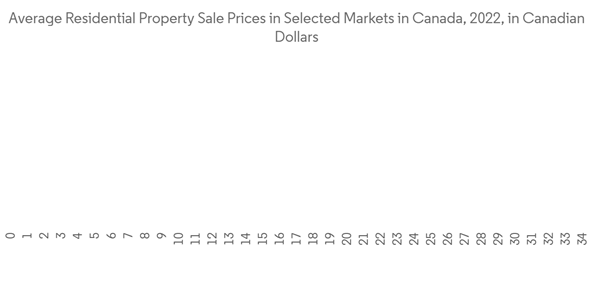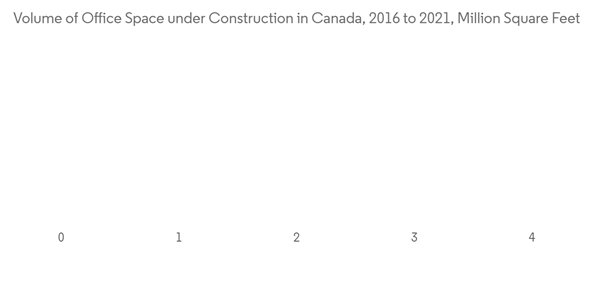Key Highlights
- The services sector will be the primary engine of growth in the upcoming years, following a significant increase in the sector of produce-duction during the early stages of the epidemic.
- Retail sales and housing market activity should spur economic growth in 2022, supporting the sector's positive performance trends. There will be challenges for Canada's consistently strong industrial demand in 2023. Further, as more customers switch to traditional stores, e-commerce sales growth, which earlier in the pandemic was a major driver of user growth, is declining. In the meantime, it's anticipated that skyrocketing inflation and rising interest rates will constrain economic growth in 2022.
- The rise in construction-related activities has been an important factor in driving the market. Furthermore, technological innovations are leading to the development of energy-saving facade materials. These advanced products absorb solar energy and find widespread adoption in several commercial and residential buildings as a secondary source of electricity generation.
- The market is expected to grow at a considerable rate over the forecast period. This growth can be attributed to rising customer spending power along with the need to provide a secure work environment to employees. Furthermore, the use of metal composite materials offers a durable, harmonious, and modern appearance to the building. Increasing usage of such composite materials to build facades is projected to boost market growth over the coming years.
- The COVID-19 pandemic hurt the market for facade devices. All construction and infrastructure projects around the globe were put on hold when the COVID-19 pandemic started in 2020. The COVID-19 pandemic has accelerated the demand for curtain wall facade opening features, though, by highlighting the necessity of establishing a healthy environment in residential, public, and commercial areas. Building occupants now have a higher need for fresh air circulation, access to outdoor spaces, and a reduced density for physical separation due to the start of the pandemic and the subsequent restart of business activity, making facade systems more distinctive and environmentally friendly.
Canada Facade Market Trends
Increasing Technological Development in Construction Industry
Because buildings can produce up to 33% of global carbon emissions, architects are working to create intelligent and energy-efficient façades. The majority of energy transfer (heat/cold) occurs through a façade, which acts as a "barrier" between customary spaces and the exterior environment. Sustainable smart façades should meet the most crucial requirements for material and energy efficiency, i.e., they should use or release the least amount of energy to ensure interior comfort. Using "Biomimetic Façades" or "Biomimicry," or replicating nature and applying it to design, architects are now utilizing the laws of nature to build intelligent façades.It is stated that inspiration may be found anywhere, and architects have produced works of art using inspiration from things like honeycombs, living things, and human skin. The three design factors that affect the thermal and aesthetic comfort of biomimetic smart façades are air/wind, shade, and climate. In addition to these, an energy-efficient façade should take into account things like solar radiation, wind speed, and humidity. A program called BioTRIZ transforms biological data analysis into technological data analysis to assist designers in incorporating nature into their work. Using this information, architects created a honeycomb-inspired roofing system that significantly reduced heat transmission by enabling longer wave radiations to travel through the open pores of the comb vertically and lowering the surface temperature.
Increasing Inclination towards Sustainability
Builders and end users alike are increasingly aware that a building's façade - no matter how opulent or modest - is about more than just aesthetics. Functionality is required to complement a stunning appearance or awe-inspiring design, including energy efficiency, insulation capabilities, strength and stability, durability, ease of installation and maintenance, competitive cost, and resistance to chemicals, fire, dampness, pests, etc. Even while there is still a market for classic façade building materials like bricks, stones, and wood, newer materials like composites made of ceramic, vinyl, and fiber cement are quickly gaining favor. Fresh technologies and materials are continuously being tested, and the market is receptive to new advances.The UN Environment Program estimates that annually, buildings and their construction account for roughly 36% of all energy used worldwide and around 40% of all greenhouse gas emissions. For instance, Pelli Clarke Pelli Architects, Inc. (PCPA) has spent the last 30 years using stainless steel in building façades. Additionally, appropriate fabrication materials are frequently employed for structures in corrosive environments or architecturally exposed structural steel applications, such as nickel-containing stainless steel that offers low heat conductivity.
Several important players are using clever strategies, such as adding curtain walls and functional façades that have a good influence on energy efficiency and have strong resistance to weather, heat, noise, light, and glare. The market for modern façades is expanding due to their inherent qualities and growing environmental and energy-related concerns throughout the world.
Canada Facade Market Competitor Analysis
The Canada Facade market comprises local and international players, with few players dominating the market. Some of the key real estate players in the market include Rockwool Rockpanel B.V, YKK AP Inc, Saint-Gobain Corporation, Norsk Hydro ASA, and Skanska AB.The sales proportion of commercial and residential real estate properties has consistently grown due to the rising internet penetration, increasing demand, increased personal disposable incomes, surging middle-class youth population, and opportunities for government infrastructure investments.
Additional Benefits:
- The market estimate (ME) sheet in Excel format
- 3 months of analyst support
Table of Contents
Companies Mentioned (Partial List)
A selection of companies mentioned in this report includes, but is not limited to:
- Rockwool Rockpanel B.V
- YKK AP Inc
- Saint-Gobain Corporation
- Norsk Hydro ASA
- Skanska AB
- Wienerberger
- Kawneer Company, Inc.
- Schuco International KG
- Reynaers
- Trimo D.O.O










